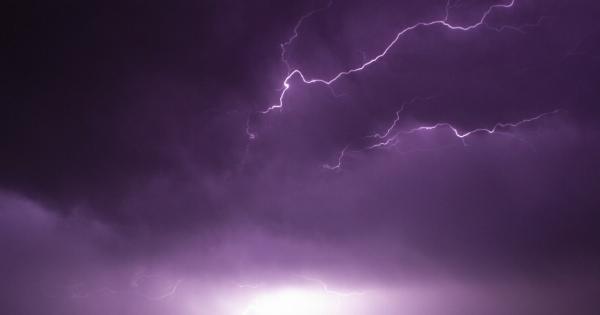Headaches can be debilitating, affecting millions of individuals around the world. While there are various triggers for headaches, one factor that often goes unnoticed is the weather.
Many people report experiencing headaches during certain weather conditions, and researchers have begun to uncover the scientific explanation behind these weather-related headaches. In this article, we will explore the science behind these headaches and understand why they occur.
Understanding Weather-Related Headaches
Weather-related headaches, also known as atmospheric pressure headaches or barometric headaches, are often triggered by changes in the atmospheric pressure and other weather-related factors.
These headaches typically occur when there is a significant drop in barometric pressure, which is the pressure exerted by the atmosphere on the Earth’s surface.
Barometric pressure tends to drop before rainy or stormy weather, and this change in pressure can affect the air pressure within our sinuses and the walls of our blood vessels. It is this fluctuation that triggers headaches in susceptible individuals.
The Role of Barometric Pressure
Barometric pressure refers to the weight of the air pressing down on the Earth’s surface. It fluctuates based on various factors such as temperature, altitude, and the movement of weather systems.
When barometric pressure drops, the air molecules exert less force on our bodies.
Our bodies are accustomed to a specific atmospheric pressure, and any sudden changes can disrupt the equilibrium within our system.
The drop in barometric pressure can affect the pressure inside our sinuses, leading to inflammation and triggering headaches. Similarly, blood vessels in the brain may expand or contract in response to these pressure changes, causing pain and discomfort.
The Link to Migraines
Migraines are a specific type of headache that is often associated with weather changes. While migraines can have multiple triggers, weather-related factors are known to affect many individuals living with this condition.
In fact, research suggests that changes in weather patterns may trigger migraines in up to 50% of migraine sufferers.
One theory regarding the connection between weather and migraines is that certain weather conditions stimulate the release of neurotransmitters like serotonin and dopamine, which play a role in regulating pain perception.
Additionally, weather-related triggers like bright sunlight, high humidity, or extreme temperatures can cause blood vessels to constrict or expand, triggering migraines in susceptible individuals.
The Influence of Temperature
Temperature can also play a significant role in weather-related headaches. Extreme temperatures, especially sudden changes, can elicit headaches in certain individuals.
Cold temperatures can cause blood vessels to constrict, while warm temperatures may lead to vasodilation. Both of these mechanisms can contribute to headaches or migraines.
Moreover, temperature changes can impact humidity levels, which can further aggravate headaches. Dry air can irritate the nasal passages and sinuses, potentially leading to congestion and headaches.
Humidity and Headaches
Humidity, a measure of the amount of water vapor present in the air, can also influence the occurrence of weather-related headaches.
High humidity levels can trigger headaches, particularly in individuals who are sensitive to changes in moisture content. The increased moisture can contribute to feelings of heaviness and pressure in the head, leading to discomfort and headaches.
Stormy Weather and Headaches
Stormy weather, particularly thunderstorms, is often associated with weather-related headaches. Thunderstorms can cause sudden shifts in barometric pressure, wind patterns, and electrical charges in the atmosphere.
These atmospheric changes can trigger a cascade of physiological responses in certain individuals, resulting in headache symptoms.
In addition to the drop in barometric pressure, lightning during thunderstorms can also produce a phenomenon known as the “storm headache.” The electrical charges in the atmosphere during lightning strikes can potentially trigger headaches and migraines in sensitive individuals.
Preventing and Managing Weather-Related Headaches
While it may be challenging to completely avoid weather-related headaches, there are strategies that can help prevent and manage them:.
- Stay hydrated: Drinking plenty of water can help maintain proper hydration levels, which can reduce the risk of headaches.
- Monitor weather forecasts: Being aware of upcoming weather changes can allow you to prepare and take necessary precautions.
- Maintain a consistent routine: A regular sleep schedule, balanced meals, and stress management can help minimize headache triggers.
- Use preventive medications: If you experience frequent weather-related headaches, consult with a healthcare professional who may recommend preventive medications to manage the symptoms.
- Wear appropriate eyewear: Bright sunlight or sudden changes in lighting conditions can trigger headaches, so wearing sunglasses or protective eyewear can help.
- Practice relaxation techniques: Techniques such as deep breathing, meditation, or yoga can help reduce stress and alleviate headache symptoms.
Conclusion
Weather-related headaches can be a significant source of discomfort for many individuals.
The changes in barometric pressure, temperature, humidity, and other weather factors can disrupt the equilibrium within our bodies, leading to headaches or migraines. By understanding the science behind these headaches, we can take appropriate measures to prevent and manage them effectively.
Remember to stay hydrated, monitor weather forecasts, and practice healthy lifestyle habits to minimize the impact of weather-related headaches on your daily life.



























